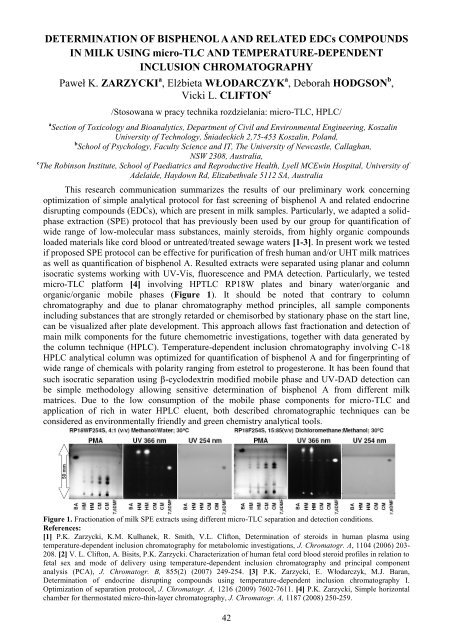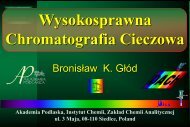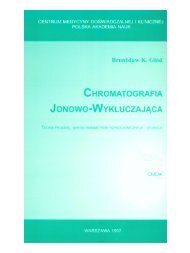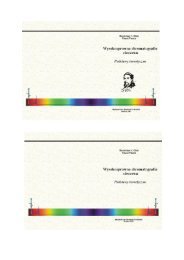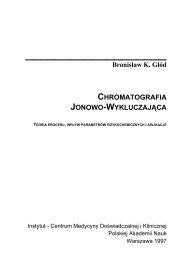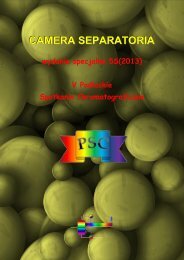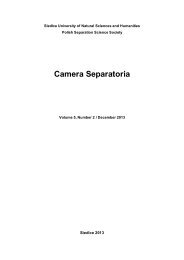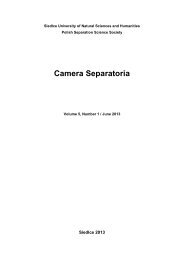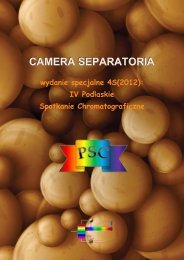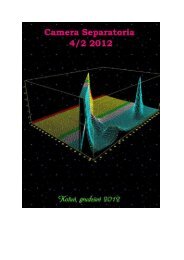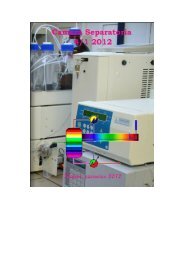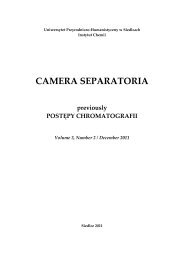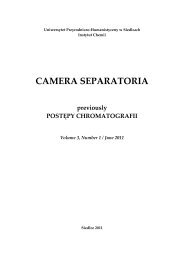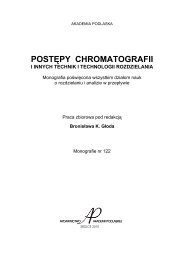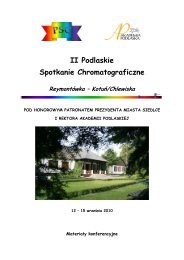CamSep 3 S
Create successful ePaper yourself
Turn your PDF publications into a flip-book with our unique Google optimized e-Paper software.
DETERMINATION OF BISPHENOL A AND RELATED EDCs COMPOUNDS<br />
IN MILK USING micro-TLC AND TEMPERATURE-DEPENDENT<br />
INCLUSION CHROMATOGRAPHY<br />
Paweł K. ZARZYCKI a , Elżbieta WŁODARCZYK a , Deborah HODGSON b ,<br />
Vicki L. CLIFTON c<br />
/Stosowana w pracy technika rozdzielania: micro-TLC, HPLC/<br />
a Section of Toxicology and Bioanalytics, Department of Civil and Environmental Engineering, Koszalin<br />
University of Technology, Śniadeckich 2,75-453 Koszalin, Poland,<br />
b School of Psychology, Faculty Science and IT, The University of Newcastle, Callaghan,<br />
NSW 2308, Australia,<br />
c The Robinson Institute, School of Paediatrics and Reproductive Health, Lyell MCEwin Hospital, University of<br />
Adelaide, Haydown Rd, Elizabethvale 5112 SA, Australia<br />
This research communication summarizes the results of our preliminary work concerning<br />
optimization of simple analytical protocol for fast screening of bisphenol A and related endocrine<br />
disrupting compounds (EDCs), which are present in milk samples. Particularly, we adapted a solidphase<br />
extraction (SPE) protocol that has previously been used by our group for quantification of<br />
wide range of low-molecular mass substances, mainly steroids, from highly organic compounds<br />
loaded materials like cord blood or untreated/treated sewage waters [1-3]. In present work we tested<br />
if proposed SPE protocol can be effective for purification of fresh human and/or UHT milk matrices<br />
as well as quantification of bisphenol A. Resulted extracts were separated using planar and column<br />
isocratic systems working with UV-Vis, fluorescence and PMA detection. Particularly, we tested<br />
micro-TLC platform [4] involving HPTLC RP18W plates and binary water/organic and<br />
organic/organic mobile phases (Figure 1). It should be noted that contrary to column<br />
chromatography and due to planar chromatography method principles, all sample components<br />
including substances that are strongly retarded or chemisorbed by stationary phase on the start line,<br />
can be visualized after plate development. This approach allows fast fractionation and detection of<br />
main milk components for the future chemometric investigations, together with data generated by<br />
the column technique (HPLC). Temperature-dependent inclusion chromatography involving C-18<br />
HPLC analytical column was optimized for quantification of bisphenol A and for fingerprinting of<br />
wide range of chemicals with polarity ranging from estetrol to progesterone. It has been found that<br />
such isocratic separation using -cyclodextrin modified mobile phase and UV-DAD detection can<br />
be simple methodology allowing sensitive determination of bisphenol A from different milk<br />
matrices. Due to the low consumption of the mobile phase components for micro-TLC and<br />
application of rich in water HPLC eluent, both described chromatographic techniques can be<br />
considered as environmentally friendly and green chemistry analytical tools.<br />
Figure 1. Fractionation of milk SPE extracts using different micro-TLC separation and detection conditions.<br />
References:<br />
[1] P.K. Zarzycki, K.M. Kulhanek, R. Smith, V.L. Clifton, Determination of steroids in human plasma using<br />
temperature-dependent inclusion chromatography for metabolomic investigations, J. Chromatogr. A, 1104 (2006) 203-<br />
208. [2] V. L. Clifton, A. Bisits, P.K. Zarzycki. Characterization of human fetal cord blood steroid profiles in relation to<br />
fetal sex and mode of delivery using temperature-dependent inclusion chromatography and principal component<br />
analysis (PCA), J. Chromatogr. B, 855(2) (2007) 249-254. [3] P.K. Zarzycki, E. Włodarczyk, M.J. Baran,<br />
Determination of endocrine disrupting compounds using temperature-dependent inclusion chromatography I.<br />
Optimization of separation protocol, J. Chromatogr. A, 1216 (2009) 7602-7611. [4] P.K. Zarzycki, Simple horizontal<br />
chamber for thermostated micro-thin-layer chromatography, J. Chromatogr. A, 1187 (2008) 250-259.<br />
42


